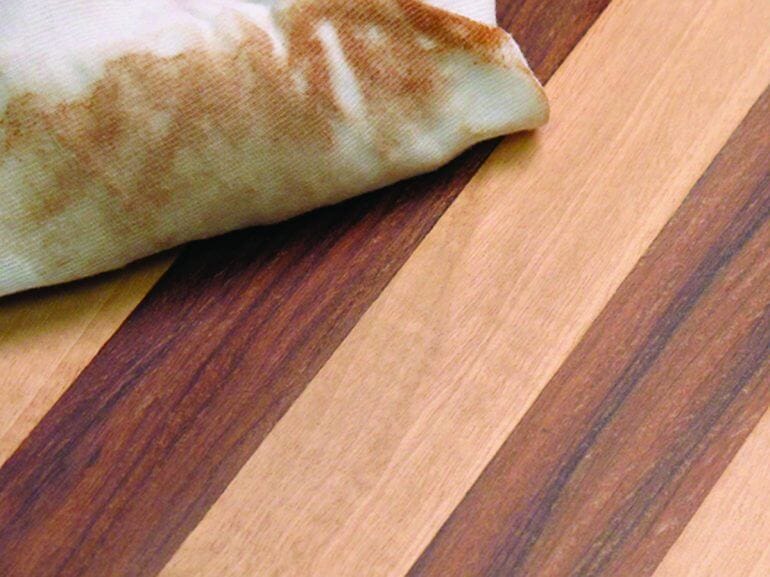Yes, acetone can be used on wood. Acetone is a powerful solvent that evaporates quickly, making it suitable for removing stubborn stains, paints, and adhesives from wood surfaces. However, it is important to use acetone sparingly and with caution as it can strip away the natural oils and finish of the wood. Always test a small, inconspicuous area before applying acetone to the entire surface, and ensure proper ventilation and safety measures are in place when using acetone.

Benefits of Using Acetone for Wood Cleaning and Restoration
When it comes to cleaning and restoring wood surfaces, one of the most effective solvents to consider is acetone. Acetone, a colorless and volatile liquid, has gained popularity in the woodworking industry due to its numerous benefits. In this section, we will delve into the advantages of using acetone for wood cleaning and restoration.

1. Powerful Cleaning Agent
Acetone is a potent cleaning agent that can effectively remove dirt, grime, grease, and even tough stains from wooden surfaces. Its solubility allows it to dissolve various substances, making it a versatile option for cleaning both finished and unfinished wood. Whether you are dealing with everyday dirt buildup or stubborn marks, acetone can provide a deep and thorough clean.
2. Fast Drying Time
One of the significant advantages of acetone is its rapid evaporation rate. Unlike other solvents, acetone dries quickly, leaving behind a clean and dry surface. This property is especially beneficial when working on larger wood projects or when time is of the essence. The fast drying time also helps minimize the risk of moisture damage to the wood.
3. Effective Paint and Varnish Remover
If you are looking to remove old paint or varnish from wood surfaces, acetone is an excellent choice. Its powerful solvent properties enable it to break down and dissolve various types of coatings, including oil-based paints and stubborn varnishes. By using acetone, you can efficiently strip away layers of unwanted finish, revealing the natural beauty of the wood beneath.
4. Restores Wood’s Natural Appearance
Over time, wood surfaces can become dull, discolored, or covered in grime. Acetone can help restore the natural beauty and luster of wood by removing surface contaminants. It can effectively remove accumulated dirt, oils, and other substances, revealing the true color and grain of the wood. This makes acetone an ideal choice for refreshing the appearance of weathered or neglected wood.
5. Easy to Use
Acetone is a user-friendly solvent that is easy to use for both professionals and DIY enthusiasts. Its liquid form allows for convenient application using a cloth, sponge, or brush. It can be readily available in most hardware stores and is often affordable compared to other specialized wood cleaners. The simplicity of application and accessibility of acetone make it a practical choice for wood cleaning and restoration projects.
6. Compatible with Various Wood Types
Whether you are working with hardwood, softwood, or engineered wood, acetone is generally safe to use on all types of wood surfaces. However, it is always recommended to perform a small patch test before applying acetone to the entire surface. This ensures that the wood does not have any adverse reactions to the solvent and helps prevent any potential damage.
7. Versatile Application
Acetone can be used for a wide range of wood cleaning and restoration tasks. It is effective in removing adhesives, glue residue, and even ink stains from wooden surfaces. Additionally, acetone can be used to clean and prepare wood before applying a new finish, such as paint or varnish. Its versatility makes it a valuable tool in any woodworking or renovation project.
In summary, using acetone for wood cleaning and restoration offers several benefits. It is a powerful cleaning agent, dries quickly, and can effectively remove paint and varnish. Acetone restores the natural appearance of wood, is easy to use, compatible with various wood types, and has versatile applications. When used correctly, acetone can help revitalize and maintain the beauty of your wood surfaces.

Precautions to Consider When Applying Acetone on Wood
Acetone is a commonly used solvent that can be effective in removing paint, glue, and other substances from wood surfaces. However, it is important to exercise caution when using acetone on wood to avoid damaging the material or causing harm to yourself. In this section, we will discuss some important precautions that you should consider when applying acetone on wood.
1. Work in a Well-Ventilated Area
Acetone emits strong fumes that can be harmful if inhaled in large quantities. Therefore, it is crucial to work in a well-ventilated area when using acetone on wood. Open windows and doors to ensure proper airflow and consider using a fan or wearing a respirator mask to protect yourself from the fumes.
2. Wear Protective Gear
When handling acetone, it is essential to protect your skin, eyes, and lungs. Wear chemical-resistant gloves to prevent direct contact with the solvent. Safety goggles or a face shield should be worn to shield your eyes from potential splashes, and a respirator mask can help filter out any harmful vapors.
3. Test on a Small, Inconspicuous Area
Before applying acetone to the entire wooden surface, it is advisable to test it on a small, inconspicuous area first. This will help you determine the compatibility of the wood with acetone and whether any adverse reactions occur. Check for any discoloration, warping, or other damage after the test spot has dried.
4. Use Acetone Sparingly
Acetone is a strong solvent that can dissolve certain finishes and damage the wood if used excessively. Start by applying a small amount of acetone on a clean cloth or sponge and gently rub the affected area. Avoid saturating the wood or leaving acetone on the surface for an extended period. If needed, repeat the process gradually until the desired results are achieved.
5. Protect Surrounding Areas
When working with acetone, it is crucial to protect surrounding areas from accidental spills or drips. Use drop cloths or plastic sheets to cover nearby furniture, flooring, or any other items that may come into contact with the solvent. This will prevent potential damage and make cleanup easier.
6. Dispose of Properly
After using acetone on wood, it is important to dispose of the solvent correctly. Acetone is flammable, so it should never be poured down the drain or thrown in the regular trash. Instead, store used acetone in a tightly sealed, labeled container and consult local regulations or recycling centers for proper disposal methods.
7. Seek Professional Help if Needed
If you are unsure about using acetone on a specific type of wood or if you encounter any difficulties during the process, it is best to seek professional help. Consult a wood restoration expert or a professional in the field who can provide guidance and ensure that the wood is safely and effectively treated.
In summary, when applying acetone on wood, it is crucial to work in a well-ventilated area, wear protective gear, test on a small area first, use acetone sparingly, protect surrounding areas, dispose of properly, and seek professional help if needed. By following these precautions, you can effectively utilize acetone for various woodworking projects while ensuring the safety of yourself and the wood surfaces.

Alternative Solvents for Wood Finishing Instead of Acetone
Wood finishing is an important process that enhances the aesthetic appeal and durability of wooden surfaces. Traditionally, acetone has been a popular solvent used in wood finishing due to its strong solvent properties and fast evaporation rate. However, acetone is known to have certain drawbacks, such as its strong odor, flammability, and potential health hazards. For those looking for alternative solvents for wood finishing instead of acetone, there are several options available that offer similar or even better results.
1. Denatured Alcohol
Denatured alcohol, also known as methylated spirits, is a common alternative to acetone for wood finishing. It is a mixture of ethanol and other additives that make the alcohol unfit for consumption. Denatured alcohol has excellent solvent properties and evaporates quickly, making it suitable for removing grease, dirt, and old finishes from wooden surfaces. It is also less toxic and has a milder odor compared to acetone.
2. Mineral Spirits
Mineral spirits, also known as white spirit or paint thinner, is another alternative solvent for wood finishing. It is a petroleum-based solvent that is commonly used to clean and degrease surfaces. Mineral spirits are effective in removing oils, waxes, and varnishes from wood without causing damage. They have a slower evaporation rate compared to acetone, allowing for a longer working time. However, they may have a stronger odor and are flammable, so caution should be exercised when using them.
3. Naphtha
Naphtha is a solvent derived from petroleum that is often used as a substitute for acetone in wood finishing. It has similar solvency power and evaporation rate, making it suitable for removing old finishes and cleaning wooden surfaces. Naphtha is less toxic than acetone and has a milder odor, making it a preferred choice for those concerned about health and environmental impacts. However, it is important to note that naphtha is flammable and should be used with caution.
4. Ethyl Lactate
Ethyl lactate is a biodegradable solvent derived from renewable resources, such as corn or sugarcane. It is gaining popularity as an eco-friendly alternative to acetone for wood finishing. Ethyl lactate has good solvency power and a moderate evaporation rate. It can effectively remove oils, resins, and stains from wood without posing significant health risks. Additionally, it has a mild odor, making it a more pleasant option to work with.
5. D-Limonene
D-Limonene is a natural solvent extracted from citrus fruits, primarily oranges. It is considered an eco-friendly alternative to acetone and other petroleum-based solvents. D-Limonene has excellent solvency power and a pleasant citrus aroma. It can effectively remove adhesives, oils, and other residues from wooden surfaces. However, it is important to note that D-Limonene is sensitive to heat and light, so proper storage is essential to maintain its effectiveness.
In summary, acetone has been a commonly used solvent for wood finishing, but it has various drawbacks including strong odor, flammability, and potential health hazards. Thankfully, there are several alternative solvents available that can provide similar or even better results. Denatured alcohol, mineral spirits, naphtha, ethyl lactate, and D-Limonene are all viable options that offer different advantages such as lower toxicity, milder odor, and eco-friendliness. When choosing an alternative solvent, it is important to consider the specific requirements of your wood finishing project and prioritize safety and environmental concerns.
Common Mistakes to Avoid When Using Acetone on Wood
Acetone is a commonly used solvent that can be effective for various purposes, including removing paint and adhesive residues from wood surfaces. However, if not used correctly, acetone can cause damage to the wood and lead to undesirable results. To ensure a successful outcome and prevent any mishaps, it is important to be aware of and avoid these common mistakes when using acetone on wood:
- Not testing in an inconspicuous area: Before applying acetone to the entire wood surface, it is crucial to first test it in a small, hidden area. This will help you determine how the wood reacts to acetone and whether it causes any discoloration or damage. By testing in an inconspicuous spot, you can avoid ruining the entire piece of wood.
- Using too much acetone: Acetone is a strong solvent, and using excessive amounts can be harmful to the wood. It is important to apply acetone sparingly and only use the amount necessary to achieve the desired result. Using too much acetone can strip away the natural oils and finishes of the wood, leading to dryness and damage.
- Not wearing protective gear: Acetone is a volatile substance that can be harmful if it comes into contact with the skin, eyes, or respiratory system. When working with acetone, it is essential to wear protective gloves, safety glasses, and a mask to prevent any direct exposure. Safety should always be a top priority.
- Not ventilating the area: Acetone emits strong fumes that can be harmful if inhaled in large quantities. It is crucial to work in a well-ventilated area to ensure proper air circulation. Open windows or use fans to help dissipate the fumes and prevent any health risks associated with inhaling acetone vapors.
- Leaving acetone on the wood for too long: Acetone should not be left on the wood surface for an extended period. It is a fast-acting solvent that can dissolve finishes and damage the wood if left for too long. Always follow the manufacturer’s instructions and avoid prolonged exposure to acetone.
- Using acetone on sensitive or antique wood: Certain types of wood, especially antique or delicate wood, may not react well to acetone. Before using acetone on sensitive wood surfaces, it is advisable to consult with a professional or conduct thorough research to ensure that it is safe to use. Using acetone on sensitive wood without proper knowledge can result in irreparable damage.
- Not following up with proper wood care: After using acetone on wood, it is essential to follow up with appropriate wood care to restore its natural beauty and protect it from further damage. This may involve applying a suitable wood finish, such as varnish or wax, to rejuvenate the appearance and enhance the wood’s durability.
In summary, using acetone on wood can be a practical solution for removing unwanted substances. However, it is crucial to avoid common mistakes to prevent any damage to the wood surface. By following these tips and taking the necessary precautions, you can successfully use acetone on wood and achieve the desired results without compromising its integrity.
FAQs
Can you use acetone on wood?
It is not recommended to use acetone on wood as it can strip the finish, stain, or damage the wood surface. Acetone is a strong solvent that can dissolve or soften wood finishes and can also remove paint or stain from wood surfaces.
Conclusion:
In conclusion, acetone can be used on wood, but caution must be exercised. While acetone is a powerful solvent that can effectively remove stains, finishes, and adhesives from wood surfaces, it can also damage the wood if used improperly. It is important to test acetone in a small, inconspicuous area before applying it to the entire surface. Additionally, acetone should be used sparingly and with gentle, circular motions to avoid stripping away the wood’s natural oils and causing discoloration or degradation. Always ensure proper ventilation and use protective gloves when working with acetone.
Overall, acetone can be a useful tool in wood maintenance and restoration, but it is essential to follow safety guidelines and use it judiciously to achieve the desired results without harming the wood.